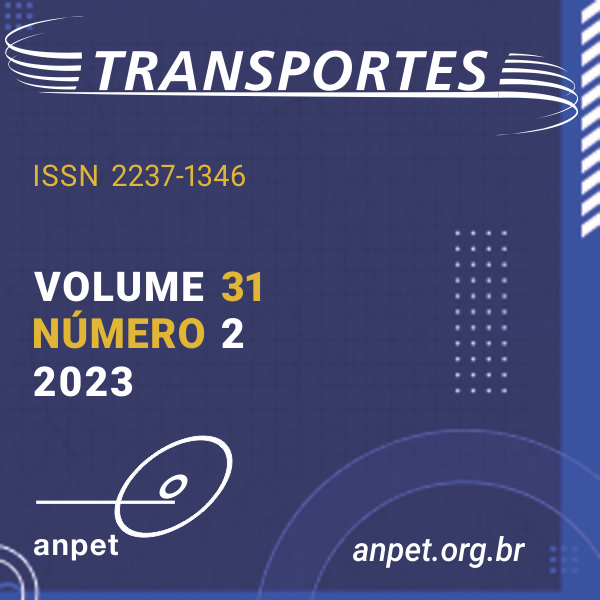Relação espacial entre dados sociodemográficos e de acesso ao varejo e as entregas do comércio eletrônico: o caso de Belo Horizonte (Brasil)
DOI:
https://doi.org/10.58922/transportes.v31i2.2820Palavras-chave:
Entregas de comércio eletrônico, Transporte urbano de mercadorias, Análise espacialResumo
As entregas ao domicílio derivadas do comércio eletrônico são uma grande preocupação em áreas urbanas devido às suas externalidades negativas associadas. Apesar de muitas soluções para esse problema, a falta de compreensão do padrão espacial das entregas urbanas torna difícil a implementação dessas estratégias. Neste artigo é analisada a relação espacial entre dados sociodemográficos e de acesso ao varejo e entregas de comércio eletrônico em Belo Horizonte (Brasil) usando dados oficiais em nível de bairro (número de lojas tradicionais de varejo, gênero, renda, idade, raça e tamanho da família) e dados operacionais de uma empresa de transporte. O índice Global Moran’s I indicou a dependência espacial das entregas do e-commerce. Os resultados de um modelo de regressão geograficamente ponderada mostraram um efeito espacial positivo do acesso ao varejo tradicional, mulheres, população asiática, idade de 20 a 29 anos e renda. Além disso, foi identificado efeito espacial negativo para o tamanho do domicílio, idade de 18 a 19 anos e população negra. Além disso, os coeficientes estimados apresentam uma pequena variabilidade espacial, indicando homogeneidade na relação espacial. A uniformidade dos parâmetros permite concluir que estratégias alternativas de entrega em domicílio podem ser implementadas de forma equitativa em todo o território para reduzir as externalidades das entregas de e-commerce e, consequentemente, contribuir para o desenvolvimento sustentável.
Downloads
Referências
Beckers, J.; I. Cárdenas and A. Verhetsel (2018) Identifying the geography of online shopping adoption in Belgium. Journal of Retailing and Consumer Services, v. 45, p. 33-41. DOI: 10.1016/j.jretconser.2018.08.006. DOI: https://doi.org/10.1016/j.jretconser.2018.08.006
Beckers, J.; A. Verhetsel (2021) The sustainability of the urban layer of e-commerce deliveries: the Belgian collection and delivery point networks. European Planning Studies, v. 29, p. 2300-2319. DOI: 10.1080/09654313.2021.1921118. DOI: https://doi.org/10.1080/09654313.2021.1921118
Bivand, R.S.; E. Pebesma and V. Gomez-Rubio (2013) Applied Spatial Data Analysis with R. New York: Springer. DOI: 10.1007/978-1-4614-7618-4. DOI: https://doi.org/10.1007/978-1-4614-7618-4
Blasio, G. (2008) Urban-rural differences in internet usage, e-commerce, and e-banking: evidence from Italy. Growth and Change, v. 39, n. 2, p. 341-367. DOI: 10.1111/j.1468-2257.2008.00422.x. DOI: https://doi.org/10.1111/j.1468-2257.2008.00422.x
Cao, X.; Q. Chen and S. Choo (2013) Geographic distribution of e-shopping: application of structural equation models in the Twin Cities of Minnesota. Transportation Research Record, v. 2383, n. 1, p. 18-26. DOI: 10.3141/2383-03. DOI: https://doi.org/10.3141/2383-03
Cheng, C.; T. Sakai; A. Alho et al. (2021) Exploring the relationship between locational and household characteristics and e-commerce home delivery demand. Logistics, v. 5, n. 2, p. 29. DOI: 10.3390/logistics5020029. DOI: https://doi.org/10.3390/logistics5020029
Clarke, G.; C. Thompson and M. Birkin (2015) The emerging geography of e-commerce in British retailing. Regional Studies, Regional Science, v. 2, n. 1, p. 371-391. DOI: 10.1080/21681376.2015.1054420. DOI: https://doi.org/10.1080/21681376.2015.1054420
Eurostat (2022) E-commerce statistics for individuals. Available at: <https://ec.europa.eu/eurostat/statisticsexplained/index.php?title=E-commerce_statistics_for_individuals> (accessed 04/04/2023).
Farag, S.; M. Dijst and M. Lanzendorf (2003) Exploring the use of e-shopping and its impact on personal travel behavior in The Netherlands. Transportation Research Record, v. 1858, n. 1, p. 47-54. DOI: 10.3141/1858-07. DOI: https://doi.org/10.3141/1858-07
Farag, S.; T. Schwanen and M. Dijst (2005) Empirical investigation of online searching and buying and their relationship to shopping trips. Transportation Research Record, v. 1926, n. 1, p. 242-251. DOI: 10.1177/0361198105192600128. DOI: https://doi.org/10.1177/0361198105192600128
Farag, S.; T. Schwanen; M. Dijst et al. (2007) Shopping online and/or in-store? A structural equation model of the relationships between e-shopping and in-store shopping. Transportation Research Part A, Policy and Practice, v. 41, n. 2, p. 125-141. DOI: 10.1016/j.tra.2006.02.003. DOI: https://doi.org/10.1016/j.tra.2006.02.003
Farag, S.; K.J. Krizek and M. Dijst (2006a) E-shopping and its relationship with in-store shopping: empirical evidence from The Netherlands and the USA. Transport Reviews, v. 26, n. 1, p. 43-61. DOI: 10.1080/01441640500158496. DOI: https://doi.org/10.1080/01441640500158496
Farag, S.; J. Weltevreden; T. van Rietbergen et al. (2006b) E-shopping in the Netherlands: does geography matter?. Environment and Planning B: Planning and Design, v. 33, n. 1, p. 59-74. DOI: 10.1068/b31083. DOI: https://doi.org/10.1068/b31083
Fotheringham, A.S. and T.M. Oshan (2016) Geographically weighted regression and multicollinearity: dispelling the myth. Journal of Geographical Systems, v. 18, n. 4, p. 303-329. DOI: 10.1007/s10109-016-0239-5. DOI: https://doi.org/10.1007/s10109-016-0239-5
Fotheringham, A.S.; C. Brunsdon and M. Charlton (2002) Geographically Weighted Regression: The Analysis of Spatially Varying Relationships. West Sussex: John Wiley and Sons.
Fox, J. and S. Weisberg (2019) An R Companion to Applied Regression. Thousand Oaks: Sage.
Gollini, I.; B. Lu; M. Charlton et al. (2015) GWmodel: an R package for exploring spatial heterogeneity using geographically weighted models. Journal of Statistical Software, v. 63, n. 17, p. 1-50. DOI: 10.18637/jss.v063.i17. DOI: https://doi.org/10.18637/jss.v063.i17
Grekousis, G. (2020) Spatial Analysis Methods and Practice: Describe – Explore – Explain through GIS. Cambridge: Cambridge University Press. DOI: 10.1017/9781108614528. DOI: https://doi.org/10.1017/9781108614528
Hair, J.F.; W.C. Black; B.J. Babin et al. (2019) Multivariate Data Analysis. Hampshire: Cengage.
Hood, N.; R. Urquhart; A. Newing et al. (2020) Sociodemographic and spatial disaggregation of e-commerce channel use in the grocery market in Great Britain. Journal of Retailing and Consumer Services, v. 55, p. 102076. DOI: 10.1016/j.jretconser.2020.102076. DOI: https://doi.org/10.1016/j.jretconser.2020.102076
IBGE (2020) IBGE Cidades –Belo Horizonte. Available at: <https://cidades.ibge.gov.br/brasil/mg/belo-horizonte/panorama> (accessed 06/22/2023).
Jaller, M. and A. Pahwa (2020) Evaluating the environmental impacts of online shopping: a behavioral and transportation approach. Transportation Research Part D, Transport and Environment, v. 80, p. 102223. DOI: 10.1016/j.trd.2020.102223. DOI: https://doi.org/10.1016/j.trd.2020.102223
James, G; D. Witten; T. Hastie et al.(2015) An Introduction to Statistical Learning: With Applications in R. New York: Springer.
Jongen, W. (2018) The End of Online Shopping: The Future of Retail in an Always Connected World. New Jersey: World Scientific Publishing Company. DOI: 10.1142/11106. DOI: https://doi.org/10.1142/11106
Kirby-Hawkins, E.; M. Birkin and G. Clarke (2019) An investigation into the geography of corporate e-commerce sales in the UK grocery market. Environment and Planning. B, Urban Analytics and City Science, v. 46, n. 6, p. 1148-1164. DOI: 10.1177/2399808318755147. DOI: https://doi.org/10.1177/2399808318755147
Krizek, K.J.; Y. Li and S.L. Handy (2005) Spatial attributes and patterns of use in household-related information and communications technology activity. Transportation Research Record, v. 1926, n. 1, p. 252-259. DOI: 10.1177/0361198105192600129. DOI: https://doi.org/10.1177/0361198105192600129
Lee, R.J.; I.N. Sener and S.L. Handy (2015) Picture of online shoppers: specific focus on Davis, California. Transportation Research Record, v. 2496, n. 1, p. 55-63. DOI: 10.3141/2496-07. DOI: https://doi.org/10.3141/2496-07
Lee, R.J.; I.N. Sener; P.L. Mokhtarian et al. (2017) Relationships between the online and in-store shopping frequency of Davis, California residents. Transportation Research Part A, Policy and Practice, v. 100, p. 40-52. DOI: 10.1016/j.tra.2017.03.001. DOI: https://doi.org/10.1016/j.tra.2017.03.001
Loo, B.P.Y. and B. Wang (2018) Factors associated with home-based e-working and e-shopping in Nanjing, China. Transportation, v. 45, n. 2, p. 365-384. DOI: 10.1007/s11116-017-9792-0. DOI: https://doi.org/10.1007/s11116-017-9792-0
Lu, B.; M. Charlton; P. Harris et al. (2014) Geographically weighted regression with a non-Euclidean distance metric: a case study using hedonic house price data. International Journal of Geographical Information Science, v. 28, n. 4, p. 660-691. DOI: 10.1080/13658816.2013.865739. DOI: https://doi.org/10.1080/13658816.2013.865739
Moran, P.A.P. (1950) Notes on continuous stochastic phenomena. Biometrika, v. 37, n. 1-2, p. 17-23. DOI: 10.1093/biomet/37.1-2.17. PMid:15420245. DOI: https://doi.org/10.1093/biomet/37.1-2.17
Motte-Baumvol, B.; L. Belton-Chevallier; L. Dablanc et al. (2017) Spatial dimensions of e-shopping in France. Asian Transport Studies, v. 4, n. 3, p. 585-600. DOI: 10.11175/eastsats.4.585.
Nielsen (2022) Webshoppers. Available at: <https://nielseniq.com/global/pt/landing-page/ebit/nielseniq-ebitbrasil/webshoppers/> (accessed 04/04/2023).
OECD (2020) E-commerce in the time of COVID-19. Available at: <https://www.oecd.org/coronavirus/policyresponses/e-commerce-in-the-time-of-covid-19-3a2b78e8/> (accessed 04/04/2023).
Rai, H.B.; S. Verlinde and C. Macharis (2019) The “next day, free delivery” myth unravelled. International Journal of Retail & Distribution Management, v. 47, n. 1, p. 39-54. DOI: 10.1108/IJRDM-06-2018-0104. DOI: https://doi.org/10.1108/IJRDM-06-2018-0104
Ren, F. and M.-P. Kwan (2009) The impact of geographic context on e-shopping behavior. Environment and Planning B: Urban Analytics and City Science, v. 36, n. 2, p. 262-278. DOI: 10.1068/b34014t. DOI: https://doi.org/10.1068/b34014t
Saphores, J.-D. and L. Xu (2021) E-shopping changes and the state of e-grocery shopping in the US-evidence from national travel and time use surveys. Research in Transportation Economics, v. 87, p. 100864. DOI: 10.1016/j.retrec.2020.100864. DOI: https://doi.org/10.1016/j.retrec.2020.100864
Sener, I.N. and P.R. Reeder (2012) An examination of behavioral linkages across ICT choice dimensions: copula modeling of telecommuting and teleshopping choice behavior. Environment and Planning A: Economy and Space, v. 44, n. 6, p. 1459-1478. DOI: 10.1068/a44436. DOI: https://doi.org/10.1068/a44436
Silveira, L.S. and S.N. Leão (2020) O impacto da segregação ocupacional por gênero e raça na desigualdade de renda no Brasil em três décadas (1986-2015). Revista Latinoamericana de Población, v. 14, n. 27, p. 41-76. DOI: 10.31406/relap2020.v14.i12.n27.2. DOI: https://doi.org/10.31406/relap2020.v14.i12.n27.2
Song, Z. (2021) The geography of online shopping in China and its key drivers. Environment and Planning. B, Urban Analytics and City Science, v. 49, n. 1, p. 259-274. DOI: 10.1177/23998083211002189. DOI: https://doi.org/10.1177/23998083211002189
Statista (2021) Distribution of digital buyers in the United States as of February 2020, by age group. Available at: <https://www.statista.com/statistics/469184/us-digital-buyer-share-age-group/> (accessed 04/04/2023).
Statista (2022) Distribution of digital buyers in Brazil in 2022, by age group. Available at: <https://www.statista.com/statistics/519746/age-distribution-of-online-shoppers-in-brazil/> (accessed 04/04/2023).
UNCTAD (2021a) COVID-19 and E-commerce: a Global Review. New York: United Nations. Available at: <https://unctad.org/system/files/official-document/dtlstict2020d13_en_0.pdf> (accessed 04/04/2023).
UNCTAD (2021b) Estimates of Global E-commerce 2019 and Preliminary Assessment of COVID-19 Impac on Online Retail 2020. UNCTAD Technical Notes on ICT for Developmen Nº 118. New York: United Nations. Available at: <https://unctad.org/system/files/official-document/tn_unctad_ict4d18_en.pdf> (accessed 04/04/2023).
Zhou, Y. and X.C. Wang (2014) Explore the relationship between online shopping and shopping trips: an analysis with the 2009 NHTS data. Transportation Research Part A: Policy and Practice, v. 70, p. 1-9. DOI: 10.1016/j.tra.2014.09.014 DOI: https://doi.org/10.1016/j.tra.2014.09.014
Downloads
Publicado
Como Citar
Edição
Seção
Licença
Copyright (c) 2023 Luísa Tavares Muzzi de Sousa, Isabela Kopperschmidt de Oliveira, Leise Kelli de Oliveira, Jorge Luiz dos Santos Junior, Bruno Vieira Bertoncini

Este trabalho está licenciado sob uma licença Creative Commons Attribution 4.0 International License.
Ao submeter um manuscrito para publicação neste periódico, todos os seus autores concordam, antecipada e irrestritamente, com os seguintes termos:
- Os autores mantém os direitos autorais e concedem à Transportes o direito de primeira publicação do manuscrito, sem nenhum ônus financeiro, e abrem mão de qualquer outra remuneração pela sua publicação pela ANPET.
- Ao ser publicado pela Transportes, o manuscrito fica automaticamente licenciado sob a Licença Creative Commons CC BY 4.0. Esta licença permite o seu compartilhamento com reconhecimento da autoria e da publicação inicial neste periódico.
- Os autores têm autorização para assumir contratos adicionais separadamente, para distribuição não exclusiva da versão do trabalho publicada neste periódico (por ex.: publicar em repositório institucional ou como capítulo de livro), com reconhecimento da publicação inicial na Transportes, desde que tal contrato não implique num endosso do conteúdo do manuscrito ou do novo veículo pela ANPET.
- Os autores têm permissão e são estimulados a publicar e distribuir seu manuscrito online (por ex.: em repositórios institucionais ou na sua página pessoal) depois de concluído o processo editorial. Como a Transportes é de acesso livre, os autores são estimulados a usar links para o DOI do artigo nesses casos.
- Os autores garantem ter obtido a devida autorização dos seus empregadores para a transferência dos direitos nos termos deste acordo, caso esses empregadores possuam algum direito autoral sobre o manuscrito. Além disso, os autores assumem toda e qualquer responsabilidade sobre possíveis infrações ao direito autoral desses empregadores, isentando a ANPET e a Transportes de toda e qualquer responsabilidade neste sentido.
- Os autores assumem toda responsabilidade sobre o conteúdo do manuscrito, incluindo as devidas e necessárias autorizações para divulgação de dados coletados e resultados obtidos, isentando a ANPET e a Transportes de toda e qualquer responsabilidade neste sentido.










